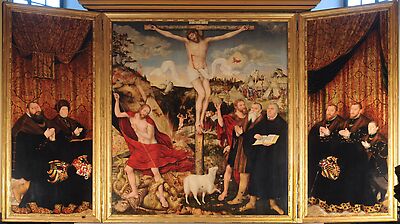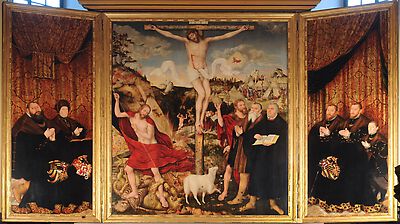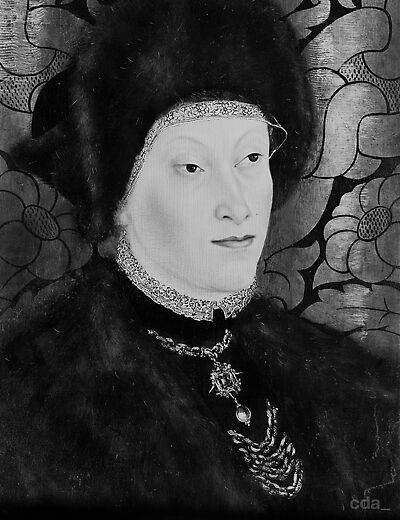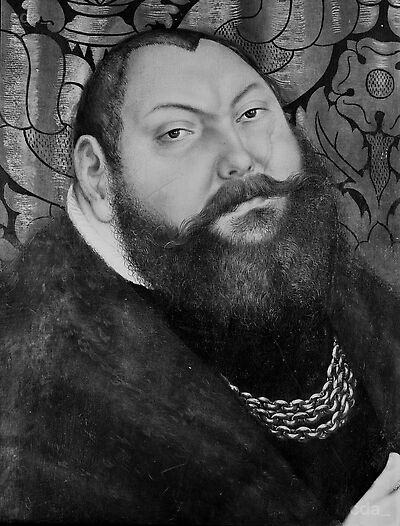| Teget-Welz 2018 |
213, 215 |
|
Fig. 1 |
| Author | Manuel Teget-Welz |
|---|
| Title | Von Gotha in die Ganze Welt. Die Fürstenserie des Monogrammisten IS |
|---|
| Publication | in Klaus Weschenfelder, ed., Cranach in Coburg. Gemälde von Lucas Cranach d.Ä., Lucas Cranach d.J., der Werkstatt und des Umkreises in den Kunstsammlungen der Veste Coburg |
|---|
| Place of Publication | Regensburg |
|---|
| Year of Publication | 2018 |
|---|
| Pages | 209-228 |
|---|
|
| Görres 2017 B |
50 |
|
Fig. 6 |
|
|
| Heydenreich 2017 A |
75 |
|
|
|
|
| Bonnet, Görres 2015 |
74-77 |
26 |
p. 74, 77 |
| Author | Anne-Marie Bonnet, Daniel Görres |
|---|
| Title | Lucas Cranach d. Ä. - Maler der Deutschen Renaissance |
|---|
| Place of Publication | Munich |
|---|
| Year of Publication | 2015 |
|---|
|
| Exhib. Cat. Weimar 2015 |
11, 12, 14, 15, 18, 19, 25, 36, 38, 40-42, 46, 53, 54, 62, 63, 74, 88, 111 |
|
|
| Editor | Wolfgang Holler, Karin Kolb |
|---|
| Title | Cranach in Weimar, [Weimar, Schiller-Museum, 3 April - 14 June 2015] |
|---|
| Place of Publication | Dresden |
|---|
| Year of Publication | 2015 |
|---|
|
| Görres 2015 A |
245-247, 253, 254 |
|
Fig. 1 |
|
|
| Görres 2015 B |
|
|
|
| Author | Daniel Görres |
|---|
| Title | Cranach, Luther und die Ernestiner. Der Epitaphaltar der Stadtkirche St. Peter und Paul in Weimar |
|---|
| Publication | in, Franziska Bomski, Hellmut Th. Seemann, Thorsten Valk, eds., Bild und Bekenntnis. Die Cranach-Werkstatt in Weimar |
|---|
| Place of Publication | Göttingen |
|---|
| Year of Publication | 2015 |
|---|
| Pages | 37-53 |
|---|
|
| Görres et al. 2015 |
245-247, 253, 254 |
|
Fig. 1 |
|
|
| Heydenreich et al. 2015 |
|
|
|
| Author | Gunnar Heydenreich, Ingo Sandner, Helen Smith-Contini |
|---|
| Title | Der Streit um die Autorenschaft. Das Weimarer Cranach-Retabel im Lichte technologischer Untersuchungen |
|---|
| Publication | in, Franziska Bomski, Hellmut Th. Seemann, Thorsten Valk, eds., Bild und Bekenntnis. Die Cranach-Werkstatt in Weimar |
|---|
| Series | Jahrbuch der Klassik Stiftung Weimar, Weimar |
|---|
| Place of Publication | Weimar |
|---|
| Year of Publication | 2015 |
|---|
| Pages | 193-204 |
|---|
|
| Lücke 2015 |
36, Fn. 39-41 |
|
|
| Author | Monika Lücke |
|---|
| Title | Lucas Cranach der Jüngere als Unternehmer |
|---|
| Publication | in Elke A. Werner, Anne Eusterschulte, Gunnar Heydenreich, eds., Lucas Cranach der Jüngere und die Reformation der Bilder |
|---|
| Place of Publication | Munich |
|---|
| Year of Publication | 2015 |
|---|
| Pages | 30-41 |
|---|
|
| Noble 2015 |
295 |
|
|
| Author | Bonnie Noble |
|---|
| Title | The Woman of Babylon. Seduction Reformation-Style |
|---|
| Publication | in Elke A. Werner, Anne Eusterschulte, Gunnar Heydenreich, eds., Lucas Cranach der Jüngere und die Reformation der Bilder |
|---|
| Place of Publication | Munich |
|---|
| Year of Publication | 2015 |
|---|
| Pages | 290-297 |
|---|
|
| Sandner, Heydenreich, Smith-Contini 2015 |
138, Fn. 76 |
|
|
|
|
| Sitt, Monsees 2015 |
316 |
|
|
| Author | Martina Sitt, Désirée Monsees |
|---|
| Title | Der einsame Christus am Kreuz - ein Bildtypus von Cranach dem Jüngeren in der pro-reformatorischen, bildlichen Argumentation |
|---|
| Publication | in Elke A. Werner, Anne Eusterschulte, Gunnar Heydenreich, eds., Lucas Cranach der Jüngere und die Reformation der Bilder |
|---|
| Place of Publication | Munich |
|---|
| Year of Publication | 2015 |
|---|
| Pages | 308-317 |
|---|
|
| Trümper 2015 |
26-28 |
|
Fig. 11 |
| Author | Timo Trümper |
|---|
| Title | Inszenierungsstrategien der Ernestiner |
|---|
| Publication | in Julia Carrasco, Justus Lange, Benjamin D. Spira, Timo Trümper, Stiftung Schloss Friedenstein Gotha and Museumslandschaft Hessen Kassel, eds., Bild und Botschaft. Cranach im Dienst von Hof und Reformation, [Exhib. Cat. Gotha, Kassel] |
|---|
| Place of Publication | Heidelberg |
|---|
| Year of Publication | 2015 |
|---|
| Pages | 17-28 |
|---|
|
| Waterman 2015 |
283, 285, Fn. 25 |
|
|
| Author | Joshua P. Waterman |
|---|
| Title | The Artistic Emergence of Lucas Cranach the Younger |
|---|
| Publication | in Elke A. Werner, Anne Eusterschulte, Gunnar Heydenreich, eds., Lucas Cranach der Jüngere und die Reformation der Bilder |
|---|
| Place of Publication | Munich |
|---|
| Year of Publication | 2015 |
|---|
| Pages | 280-289 |
|---|
|
| Werner 2015 |
9, 10, 11, 12, 14 |
|
|
| Author | Elke Anna Werner |
|---|
| Title | Lucas Cranach der Jüngere und die Reformation der Bilder. Zur Einführung |
|---|
| Publication | in Elke A. Werner, Anne Eusterschulte, Gunnar Heydenreich, eds., Lucas Cranach der Jüngere und die Reformation der Bilder |
|---|
| Place of Publication | Munich |
|---|
| Year of Publication | 2015 |
|---|
| Pages | 8-16 |
|---|
|
| Bonnet, Kopp-Schmidt, Görres 2010 |
186-189 |
26 |
|
| Author | Anne-Marie Bonnet, Gabriele Kopp-Schmidt, Daniel Görres |
|---|
| Title | Die Malerei der deutschen Renaissance |
|---|
| Place of Publication | Munich |
|---|
| Year of Publication | 2010 |
|---|
|
| Noble 2009 |
|
|
|
| Author | Bonnie Noble |
|---|
| Title | Lucas Cranach the Elder. Art and Devotion of the German Reformation |
|---|
| Place of Publication | Lanham |
|---|
| Year of Publication | 2009 |
|---|
|
| Böhlitz 2007 |
|
|
|
| Author | Michael Böhlitz |
|---|
| Title | Der Weimarer Cranachaltar im Kontext von Religion und Geschichte: ein ernestinisches Denkmal der Reformation |
|---|
| Publication | in Andreas Tacke, ed., Lucas Cranach 1553/2003. Wittenberger Tagungsbeiträge anlässlich des 450. Todesjahres Lucas Cranach des Älteren |
|---|
| Series | Schriften der Stiftung Luthergedenkstätten in Sachsen-Anhalt |
|---|
| Volume | 7 |
|---|
| Place of Publication | Leipzig |
|---|
| Year of Publication | 2007 |
|---|
| Pages | 277-298 |
|---|
|
| Görres 2007 |
|
|
|
| Author | Daniel Görres |
|---|
| Title | Der Cranach-Altar der Stadtkirche St. Peter und Paul in Weimar und sein Betrachter. Eine Studie zum Medium "Bild" im Kontext der Reformation |
|---|
| Publication | in Deubner-Preis 2006. Sonderdruck aus den Kunsthistorischen Arbeitsblättern (KAb) |
|---|
| Place of Publication | Cologne |
|---|
| Year of Publication | 2007 |
|---|
| Pages | 19-34 |
|---|
|
| Görres 2006 |
|
|
|
| Author | Daniel Görres |
|---|
| Title | Der Cranach-Altar der Stadtkirche St. Peter und Paul in Weimar und die Mediation des Glaubens [Thesis] |
|---|
| Place of Publication | Bonn |
|---|
| Year of Publication | 2006 |
|---|
|
| Böhlitz 2005 |
33 |
|
|
| Author | Michael Böhlitz |
|---|
| Title | Altargemälde von Lucas Cranach dem Älteren, Lucas Cranach dem Jüngeren und ihren Schülern im Chemnitzer Raum |
|---|
| Publication | in Harald Marx, Ingrid Mössinger, Karin Kolb, ed., Cranach. Exhib. Cat. Chemnitz |
|---|
| Place of Publication | Cologne |
|---|
| Year of Publication | 2005 |
|---|
| Pages | 18-43 |
|---|
|
| Exhib. Cat. Prague 2005 |
146 (English version 54) |
under no. 43 |
|
| Editor | Obrazárna Pražského hradu, Kaliopi Chamonikola |
|---|
| Title | Pod znamením okrídleného hada. Lucas Cranach a ceské zeme. Under the winged Serpent. Lucas Cranach and the Czech Land |
|---|
| Place of Publication | Prague |
|---|
| Year of Publication | 2005 |
|---|
|
| Schulze 2004 |
104-111 |
|
|
| Author | Ingrid Schulze |
|---|
| Title | Lucas Cranach d. J. und die protestantische Bildkunst in Sachsen und Thüringen. Frömmigkeit, Theologie, Fürstenreformation |
|---|
| Place of Publication | Bucha near Jena |
|---|
| Year of Publication | 2004 |
|---|
|
| Noble 1999 |
138-162 |
|
|
| Author | Bonnie Noble |
|---|
| Title | The Lutheran Paintings of the Cranach Workshop, 1529-1555 |
|---|
| Place of Publication | Ann Arbor |
|---|
| Year of Publication | 1999 |
|---|
|
| Schuchardt 1998 B |
13 |
|
|
| Author | Günter Schuchardt |
|---|
| Title | "Ich hätt euch viel zu schreiben, hab aber viel zu schaffen." Lucas Cranach d. Ä. und seine Wittenberger Werkstatt. |
|---|
| Publication | in Ingo Sandner, Wartburg-Stiftung Eisenach and Fachhochschule Köln, eds., Unsichtbare Meisterzeichnungen auf dem Malgrund. Cranach und seine Zeitgenossen, Exhib. Cat. Eisenach |
|---|
| Place of Publication | Regensburg |
|---|
| Year of Publication | 1998 |
|---|
| Pages | 11-18 |
|---|
|
| Büttner 1994 |
|
|
|
|
|
| Sandner, Ritschel 1994 |
189 |
|
|
| Author | Ingo Sandner, Iris Ritschel |
|---|
| Title | Arbeitsweise und Maltechnik Lucas Cranachs und seiner Werkstatt |
|---|
| Publication | in Claus Grimm, Johannes Erichsen, Evamaria Brockhoff, eds., Lucas Cranach. Ein Maler-Unternehmer aus Franken, Exhib. Cat. Kronach 1994 |
|---|
| Series | Veröffentlichungen zur bayerischen Geschichte und Kultur |
|---|
| Volume | 26 |
|---|
| Place of Publication | Augsburg, Coburg |
|---|
| Year of Publication | 1994 |
|---|
| Pages | 186-193 |
|---|
|
| Schade, Schuttwolf 1994 |
21 |
|
|
| Author | Werner Schade, Allmuth Schuttwolf |
|---|
| Title | Malerei und Plastik |
|---|
| Publication | in Allmuth Schuttwolf, ed., Gotteswort und Menschenbild. Werke von Cranach und seinen Zeitgenossen, Exhib. Cat. Gotha |
|---|
| Place of Publication | Gotha |
|---|
| Year of Publication | 1994 |
|---|
| Pages | 15-94 |
|---|
|
| Friedländer, Rosenberg 1979 |
|
|
|
| Author | Max J. Friedländer, Jakob Rosenberg |
|---|
| Editor | G. Schwartz |
|---|
| Title | Die Gemälde von Lucas Cranach |
|---|
| Place of Publication | Basel, Boston, Stuttgart |
|---|
| Year of Publication | 1979 |
|---|
|
| Schade 1968 B |
66-67 |
|
|
| Author | Werner Schade |
|---|
| Title | Die Epitaphbilder Lucas Cranach d. J. |
|---|
| Publication | in Bozena Steinborn, ed., Ze Studiów nad Sztuka XVI Wieku na Slasku i w Krajach Sasiednich(Materialy z konferencji urzadzonej przez Muzeum Slaskie we Wroclaw 10 i 17 grudnia 1966 roku) |
|---|
| Place of Publication | Breslau |
|---|
| Year of Publication | 1968 |
|---|
| Pages | 63-76 |
|---|
|
| Thulin 1955 |
|
|
|
| Author | Oskar Thulin |
|---|
| Title | Cranach-Altäre der Reformation |
|---|
| Place of Publication | Berlin |
|---|
| Year of Publication | 1955 |
|---|
|
| Jursch 1953 |
158 |
434 |
|
| Author | Hanna Jursch |
|---|
| Title | Der Cranach-Altar in der Stadtkirche zu Weimar |
|---|
| Journal | Wissenschaftliche Zeitschrift der Friedrich-Schiller-Universität Jena |
|---|
| Year of Publication | 1953 |
|---|
| Pages | 69-80 |
|---|
|
| Justi 1951 |
|
|
|
| Author | Ludwig Justi |
|---|
| Title | Das große dreiteilige Gemälde aus der Herderkirche zu Weimar |
|---|
| Place of Publication | Berlin |
|---|
| Year of Publication | 1951 |
|---|
|
| Exhib. Cat. Berlin 1937 |
49, 50 |
137 |
Pl. 105 |
| Editor | Staatliche Museen, Berlin |
|---|
| Title | Lucas Cranach d. Ä. und Lucas Cranach d. J. Gemälde, Zeichnungen, Graphik |
|---|
| Place of Publication | Berlin |
|---|
| Year of Publication | 1937 |
|---|
|
| Meyer 1813 |
|
|
|
| Author | Heinrich Meyer |
|---|
| Title | Über die Altar-Gemälde von Lucas Cranach in der Stadt-Kirche zu Weimar |
|---|
| Place of Publication | Weimar |
|---|
| Year of Publication | 1813 |
|---|
|
![Epitaph-altarpiece of Johann Friedrich the Magnanimous in the Weimar parish church St. Peter and Paul [left wing]](https://lucascranach.org/imageserver-2022/DE_PPW_NONE-PPW001B_FR434/01_Overall/DE_PPW_NONE-PPW001B_FR434_2010-04_Overall-s.jpg)

![Epitaph-altarpiece of Johann Friedrich the Magnanimous in the Weimar parish church St. Peter and Paul [central panel]](https://lucascranach.org/imageserver-2022/DE_PPW_NONE-PPW001A_FR434/01_Overall/DE_PPW_NONE-PPW001A_FR434_2010-04_Overall-s.jpg)
![Epitaph-altarpiece of Johann Friedrich the Magnanimous in the Weimar parish church St. Peter and Paul [right wing]](https://lucascranach.org/imageserver-2022/DE_PPW_NONE-PPW001C_FR434/01_Overall/DE_PPW_NONE-PPW001C_FR434_2010-04_Overall-s.jpg)


